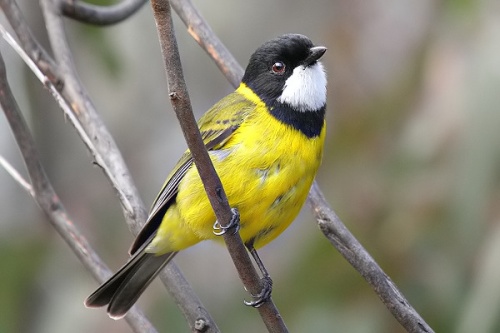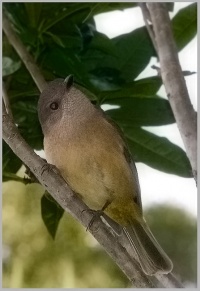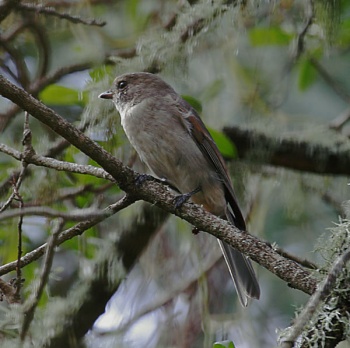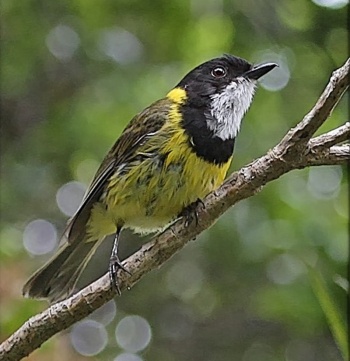Alternative name: Australian Golden Whistler
- Pachycephala pectoralis
Includes Baliem Whistler
Identification
16 - 19cm (6-7½ in).
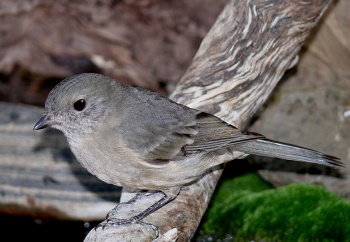
Photo by Rose Fletcher
Nangawooka Flora Reserve, Victor Harbor, South Australia, April 2008
- Black head, nape and band around upper breast
- White throat
- Yellow nape extending to breast and underparts
- Olive-green back
- Females have brownish-grey upperparts
- xanthoprocta with brownish-grey head, chin, throat and upperparts and only slightly yellow on underparts
- Similar to Black-tailed Whistler from northern Australia but note black tail in latter
Distribution
Australia and New Guinea.
Common in most of its range.
Taxonomy
Has been considered conspecific with some other Whistlers, especially with Black-tailed Whistler, Tongan Whistler, New Caledonian Whistler, Vanuatu Whistler, Oriole Whistler, Fulvous-tinted Whistler, Black-chinned Whistler, Bismarck Whistler, Western Whistler and Banda Sea Whistler.
Norfolk Island Whistler (P. p. xanthoprocta) has been proposed as a full species and other subspecies have been included in other species.
Subspecies
There are 7 subspecies[1]:
- P. p. balim:
- Northern New Guinea (Ballim and Bele valleys) - split as full species Baliem Whistler by Clements
- P. p. pectoralis:
- Eastern Australia (Cooktown, Queensland to Hunter River, New South Wales
- P. p. youngi:
- P. p. glaucura:
- Tasmania and Flinders Island (Bass Strait)
- P. p. fuliginosa:
- South-western Western Australia to south-eastern South Australia and western Victoria.
- P. p. contempta:
- Lord Howe Island
- P. p. xanthoprocta:
- Norfolk Island
Habitat
Very varied in the type of forest and scrub habitat acceptable, from rainforest and mangrove to gardens to dry scrub.
Behaviour
Diet
Feeds mainly on insects and spiders.
Breeding
In Australia, breeding season is mainly August to January. The nest is a cup made of twigs, grass, plant stems and other material. It's usually placed around 3m above the ground. Lays 2 - 3 eggs. Brood parasitism by Pallid Cuckoo, Fan-tailed Cuckoo and Brush Cuckoo reported.
Movements
Resident species. Some Australian populations known to make altitudinal movements.
References
- Clements, J. F., T. S. Schulenberg, M. J. Iliff, D. Roberson, T. A. Fredericks, B. L. Sullivan, and C. L. Wood. 2016. The eBird/Clements checklist of birds of the world: v2016, with updates to August 2016. Downloaded from http://www.birds.cornell.edu/clementschecklist/download/
- Del Hoyo, J, A Elliott, and D Christie, eds. 2007. Handbook of the Birds of the World. Volume 12: Picathartes to Tits and Chickadees. Barcelona: Lynx Edicions. ISBN 978-8496553422
- Simpson, K and N Day. 1998. Field Guide to the Birds of Australia. London: Christopher Helm. ISBN 0-7136-4877-5
- Gill, F and D Donsker (Eds). 2015. IOC World Bird Names (version 5.1). Available at http://www.worldbirdnames.org/.
Recommended Citation
- BirdForum Opus contributors. (2024) Golden Whistler. In: BirdForum, the forum for wild birds and birding. Retrieved 28 April 2024 from https://www.birdforum.net/opus/Golden_Whistler
External Links




